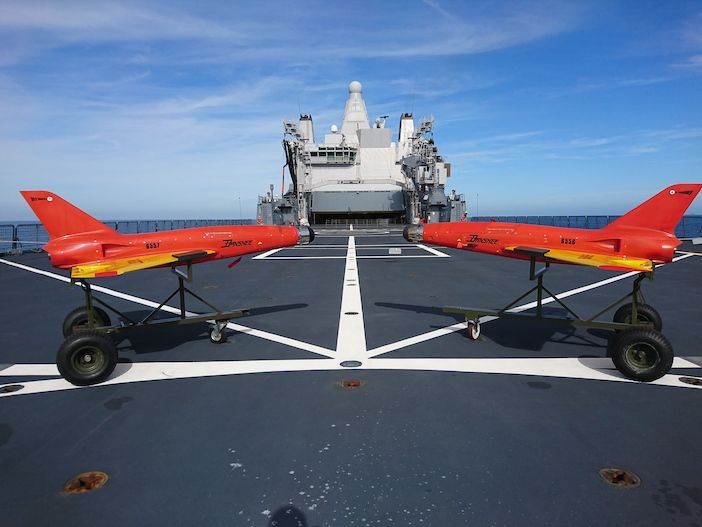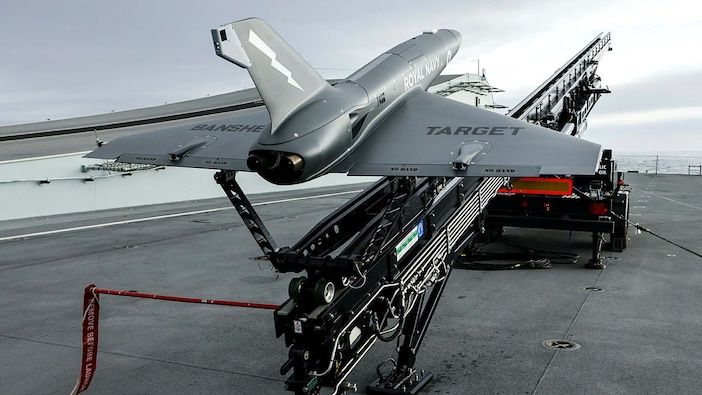The Royal Navy is to use QinetiQ’s Banshee Jet80+ targets for the first phase of its Vampire testing program, which aims to decide which drones will be flown from the UK’s aircraft carriers in the future.
The £6 million (US$8 million), four year contract award covers the first phase of Vampire program and follows the successful demonstration of QinetiQ’s Banshee Jet80+ from the deck of the Royal Navy’s HMS Prince of Wales aircraft carrier late last year.
During the Vampire project Royal Navy engineers will test and evaluate the capability of different small fixed-wing, jet-powered unmanned aerial vehicle systems (UAS) to support the Carrier’s aviation operations.
They will also train in the use of UAS on the aircraft carriers using real-world scenarios that are created using QinetiQ’s Banshee Jet80+ targets and leveraging the UK-based defence group’s testing and experimentation experience.
The Vampire program could lead to the further development and acquisition of UAS as part of the Royal Navy’s Future Maritime Aviation Force for the next thirty years. This is planned to be a mix of crewed and uncrewed aerial systems.
The Banshees can emulate cruise missiles and enemy fast jets which may be faced during a mission. The Banshee can operate at altitudes of 25,000ft and as low as just above the sea surface, while flying at high speeds of up to 460mph (740km/h), delivering a realistic adversary to train against.
The use of the drones as enemy aircraft helps the carriers improve their defence capabilities as the size of the Banshee is representative of an incoming missile on radar systems.
The Royal Navy will also use the contract to understand and demonstrate the wider Concepts of Operations of small and less expensive UAS to deliver capabilities in areas such as intelligence gathering, surveillance, Stand in Jamming and working as decoys. This could be either as a standalone capability or delivered though human machine teaming.
Colonel Phil Kelly, head of carrier strike and maritime aviation for the Royal Navy said, “The partnership with QinetiQ will be invaluable in our ability to support our training needs to better prepare for realistic threats.
“As we see these threats and the technology supporting them evolve globally, we must ensure our training is as close to the real-life situation as possible and we’re grateful that QinetiQ can support us in achieving this.”
Steve Fitz-Gerald, group managing director maritime and land, QinetiQ said, “The Vampire Phase 1 contract demonstrates QinetiQ’s capability to deliver complex training and evaluation exercises for the Royal Navy.
“The use of crewless technology is paramount to the Royal Navy’s future programmes and this UK capability, already used around the world, will deliver an efficient, value for money method of training, whether at home or during deployment overseas.”
Banshee Jet 80
Developed from the original Banshee target, the twin-jet engine powered Banshee Jet 80 version was developed using knowledge and experience gained whilst operating the single jet engine variant, the Banshee Jet 40 which entered service in 2010.

The current version is fitted with twin 40kg thrust gas turbine engines giving a total of 80kg of static thrust. This offers an increase in the maximum straight and level airspeed of up to 180m/sec.
The use of an auxiliary fuel tank ensures that endurance is similar to that of the single engine version with a typical mixed throttle mission time in excess of 45 minutes. When fitted with the patented Hot Nose the target provides a forward and side-looking IR source with output in Bands I, II and III, whilst the jet engines provide a realistic rearward looking IR signature.
Related Stories
How target drones are used in aerospace testing





